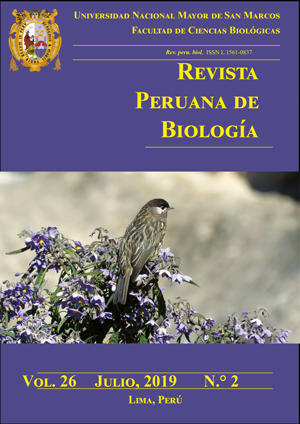Diet and trophic structure in an assemblage of bats in montane forest of Pampa Hermosa National Sanctuary, Junin, Peru
DOI:
https://doi.org/10.15381/rpb.v26i2.16375Keywords:
diet, bats, elevations, functional groups, specialization, phylogenyAbstract
We study the diet and trophic structure of 36 bat species from the Pampa Hermosa National Sanctuary. Faeces samples and gels with pollen were analyzed; seeds, pollen and remains of arthropods were found in the feces. Bats were classified in six functional groups. We found in the diet of the sedentary frugivores (FS), frugivorous nomads (FN) and nectarivores (N), 70 morphospecies of seed and pollen; in the diet of the aerial insectivorous (IA) and foliage gleaners (IR), nine morphospecies of arthropods. Principal component analysis shows the separation of bats and their diets; Carollia brevicauda-Piperaceae (Piper spp.), Vampyressa melissa-Moraceae (Ficus spp.), Sturnira lilium-Solanaceae; Anoura peruana and Anoura cultrata were separated by the consumption of Fabaceae and Bombacaceae, respectively, and Myotis spp. for the consumption of arthropods. The niche breadth was less than 0.50, in the assemblage. The values of dietary overlap were higher than 0.5, between: A. cultrata-A. caudifer (0.59), Sturnira lilium-Uroderma bilobatum (0.55), V. melissa-Platyrrhinus masu (0.62), in for the almost of AI and IR. The cluster analysis based on dietary overlap grouped to the strict frugivores Sternodermatinae in a different cluster than bats with insectivorous diets, as Carollia spp. and Anoura spp.
Downloads
Downloads
Additional Files
Published
Issue
Section
License
Copyright (c) 2019 Edith Arias, Víctor Pacheco

This work is licensed under a Creative Commons Attribution-NonCommercial-ShareAlike 4.0 International License.
AUTHORS RETAIN THEIR RIGHTS:
a. Authors retain their trade mark rights and patent, and also on any process or procedure described in the article.
b. Authors retain their right to share, copy, distribute, perform and publicly communicate their article (eg, to place their article in an institutional repository or publish it in a book), with an acknowledgment of its initial publication in the Revista Peruana de Biologia.
c. Authors retain theirs right to make a subsequent publication of their work, to use the article or any part thereof (eg a compilation of his papers, lecture notes, thesis, or a book), always indicating its initial publication in the Revista Peruana de Biologia (the originator of the work, journal, volume, number and date).






